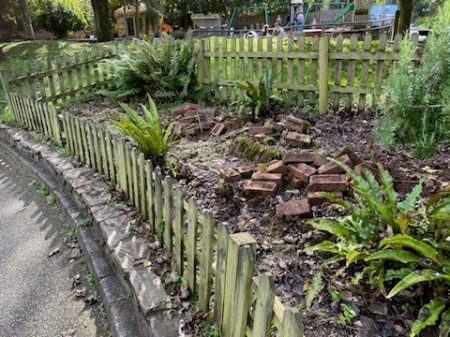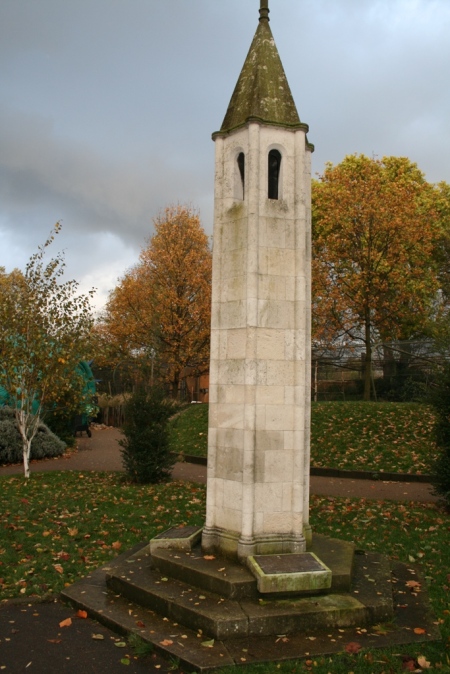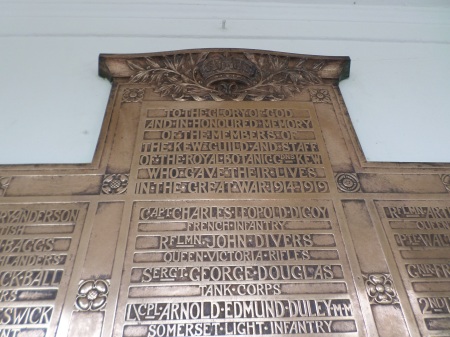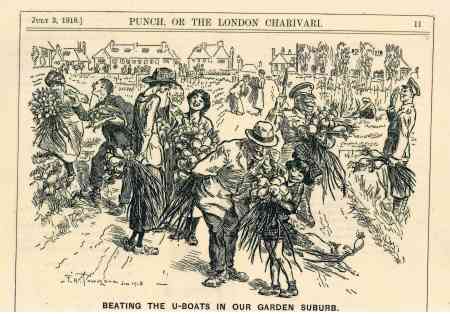
Our poor soil is getting tired, entering our 7th growing season in the World War Zoo Gardens project at Newquay Zoo, just as it would have been for gardeners entering the 1945 growing season.
The first year or two in 2009/10, our Lion House lawn turned wartime allotment must have had a certain amount of stored natural goodness, being cultivated for the first time, along with good helpings of zoo bedding and zoo manure well rotted down.
The last two autumn / winters of 2013/14 we’ve given it an organic boost with green manures of mustard and clover grown and dug in before flowering. Like Heligan, we have used the traditional seaside remedies of using seaweed solutions or mulched sea weed dug and rotted down.
Since 2009 we’ve been keeping it ‘semi-organic’, as our garden produce is not just for show but practically for our zoo animals. I have to be wary of chemicals and pesticides that would have been the quick fix for soil and pest problems in WW2.
It’s International Year of the Soil in 2015 (IYS) and December the 5th is now an annual World Soil Day, focussing on the growing challenge of feeding a growing world’s population with a potentially finite resource of soil. Much the same food security challenge faced farmers and food ministers in the wartime and post-war wrecked economy after World War 2.

The Soil Association’s clever fusion of Renaissance artist Arcimboldo and the WW1 Kitchener poster (Source: Soil Association / World War Zoo gardens collection, Newquay Zoo)
In future blogposts I will look at the organic and hydroponic movement that arose out of wartime and post-war food production and intensification of farming. Few realised in the desperate state of wartime a nd positive view that ‘Science’ would solve all post-war problems until the slow discovery that some ‘miracle’ or quick-fix wartime pesticides like DDT would lead to the ‘Silent Spring’ of pollution in the 1950s and 1960s, as Rachel Carson christened the disastrous impact on wildlife and human health. But for now, I shall look at and try out the wartime solution of a simple and still much-loved chemical fertiliser.
Update 15 March 2015: As compromise and inspired by 1970s dandruff adverts, I will feed one half of the allotment National Growmore chemical fertiliser, the other half of the plot I will the leave as organic green manure fuelled or maybe Organic Blood Fish and Bone as an experiment.

Modern Growmore next to the campaign signs of what replaced the National Growmore Campaign, Dig For Victory!
World War Zoo Gardens Project, Newquay Zoo, January 2015
This year for the first time, I’ll be using ‘Artificials’, taking my wartime gardening advice from the Ministry of Agriculture leaflets for 1945. We have acquired many of these Ministry of Ag original leaflets for our archive but for muddy garden use and display we use a recent reprint.
These have been reprinted recently as Allotment and Garden Guide: A Monthly Guide to Better Wartime Gardening published by Sabrestorm (www.sabrestorm.com) in 2009 edited by Garden historian Twigs Way. It describes Growmore in January 1945 as:
A SOUND GOVERNMENT FERTILISER
“To meet the needs of gardeners the Government arranged for the supply of a good standard fertiliser at a reasonable price. It is called “National Growmore Fertilser” and contains the three important plant foods – the analysis being 7 % N. (Nitrogen), 7 % Phosphate and 7 % Potash …”
“On most soils 42 lb of National Growmore Fertiliser should be sufficient for a 10 Rod Plot (300 square yards). A few days before sowing or planting, scatter 1 lb. evenly over 10 square yards and rake in.”
“To give this general dressing to a 10-Rod allotment will take 30 lbs. this will leave 12 lbs for giving an extra dressing for potatoes, winter green crops and spring cabbages. 4.5 lbs should be reserved for potatoes and should be applied at planting time. 5.5 lbs should be kept for applying during August to the autumn and winter green crops when they are making active growth. The remaining 2 lbs should be used during March as top dressing for Spring cabbage.”

How every well dressed gardener should appear on the allotment – National Growmore Fertiliser illustration from the February 1945 Min of Ag Allotment Guide
The January 1945 leaflet goes on to suggest bulk buying if you can organise enough people to spilt the volumes ordered. This reminds me of childhood trips with my Dad to the local allotment society ‘potting shed’ on a Sunday to buy his share of the bulk bought fertiliser, seeds and such. With no car, we must have carried it or wheelbarrowed it home. The smell of such places is quite evocative, dusty, fish, blood and bone, quite different from a modern garden centre.
“You will be able to get National Growmore Fertiliser from most sundries merchants. Allotment Societies and similar bodies, which have hitherto bought their fertilisers in bulk, are able to buy National Growmore Fertiliser in bulk at reduced prices.”
“On some allotments or in some gardens it may be necessary to give an additional top dreessing of a nitrogenous fertiliser (such as Sulphate of Ammonia) to any growing crops, applying it at the rate of about 1 lb per 10 square yards.” (January 1945 Min of Ag leaflet p. 3-4)
Sundries merchants, hitherto – they just don’t write paragraphs like that anymore. As vanished as the evocative small of the local allotment society potting shed shop? Thankfully National Growmore Fertiliser is still alive and well available from most garden centres from several manufacturers such as J. Arthur Bowers and Vitax still made “to original ‘dig for victory’ formula” – http://www.vitax.co.uk/home-garden/vitax-growmore/
It also appears again on the REMINDERS monthly page for January 1945 Get Your Fertilisers Now. “Make sure of your fertilisers now, so that you have them at hand when needed”

Maybe gloves should be worn today … How to dress to scatter National Growmore Fertiliser, illustration from the January 1945 Min of Ag Allotment Guide.
So important was Growmore to tired wartime soil and tired wartime gardeners that it was mentioned again in the February 1945 Allotment and Garden Guide Vol 1 No. 2. The end of the war was in sight after hard fighting but still the need to grow postwar crops meant that these leaflets carried on being published well past the end of the war in August 1945. Dig for Victory became Dig for Plenty, as rationing carried on for almost another ten years until 1954. Crop Rotation, compost, all these were important reminders to the winter gardener: “But before you get down to planning, have you yet got or ordered what you will need when you start outdoor operations? These are the items : SEEDS * SEED POTATOES * FERTILISERS *”

Lovely Black and White line illustrations, National Growmore Fertiliser illustration from the February 1945 Min of Ag Allotment Guide
A page or two later it has another reminder: “Have you got your NATIONAL GROWMORE FERTILISER? you will need it for dressing your land before sowing and planting. it contains the three essential plant foods in balanced proportions …”
It crops up again in the Jobs Reminders, in March 1945: “Feed Spring cabbage … Lettuces and Spinach … but keep the fertiliser off the leaves” and then onwards month by month in the Reminders. By July 1945, the war in Europe and VE day was over but things were still uncertain in the Far East. Reminders continued to gardeners to plant and sow to bridge the hungry gap next Spring 1946.

Handy topical monthly hints from the Ministry of Food’s 1945 wartime gardening guide.
What is National Growmore Fertiliser?
National Growmore is an inorganic or chemical fertiliser, broadly similar in its 7% each of Potash, Nitrogen and Phosphoric acid balance of nutrients (NPK 7:7:7) to more traditional organic fertilisers like Blood, Fish and Bone.
Before the war, nitrogenous fertilisers had existed in large numbers since Victorian times thanks to Chemists like Leibig and Humphry Davy. Prewar it would have been manufactured or sold by seed companies such as Sutton’s who offered a range of fertilisers:
- Icthelmic Guano (sea bird poo, the reason some of our sea birds like the endangered Humboldt Penguins at Newquay Zoo became rarer when their Peruvian beach nest sites were mined or dug back to useless bare rock )
- Poultmure, treated chicken manure, although no longer sold by Sutton’s or by this name is still available in garden centres.
- Garotta, still made under this name by several companies to speed or encourage compost breakdown.
When war broke out many of our European supplies of chemicals and chemical fertilisers such as (Sulphate of ) Potash became unobtainable, fell into enemy hands or found other competing wartime uses. Since the 1860s much of the Potash came from German or Prussian mining towns like Stassfurt. Changing times meant fewer horses meant less available farmyard manure. Meanwhile a nation of gardeners was being mobilised to replace the same food supplies that had vanished into enemy hands and that (like today) we had become dependant on from foreign imports. A simple, easy to apply and multipurpose fertiliser at low cost and widespread availability was required. National Growmore Fertiliser was the answer!

The Little Man with The Spade – unofficial logo for the National Growmore Campaign 1940.
Why Growmore?
Growmore appears to have got its simple name from an early version of the Dig For Victory campaign name and its popular Grow More food leaflets. Eventually the campaign name changed to the more familiar Dig For Victory, its little gardener man logo replaced by the famous foot on spade and postwar Dig for Plenty campaigns. Growmore remains the same name and composition to this day.
“Specifically Prepared to Produce Maximum Crops Of Vegetables”
Researching the introduction of Growmore, the National Archives files for the Ministry of Agriculture MAF 51/24 suggest a start date of 1942 “National Growmore Fertiliser, a general purpose compound fertiliser”.
Looking at selections of historic newspaper archives through family history websites such as Find My Past as a very rough sample reveals 7 mentions of National Growmore for that year, mostly in the later part of 1942, whereas there are 166 for 1943 and so on.
The Ministry of Agriculture had made great use of the well-known garden writer Roy Hay (20 August 1910 – 21 October 1989) from 1940 onwards as part of its Dig for Victory campaign. In late 1942 he was used to introduce National Growmore Fertiliser in his syndicated garden columns “Garden Hints”. Announcements appeared in many different papers ranging from the Gloucester Journal on November 11 1942, Sussex Agricultural Express on 13 November 1942 to the Essex Newsman of the same week. Much of the copy Roy Hay provided and packaged in his garden columns was reproduced or recycled in the 1945 Allotment Guide:
A Standard Fertiliser
“At last gardeners and allotment holders can buy a standard fertiliser … to sold at prices not exceeding … 1 Cwt 25 shilings .. and authorised manufacturers will be permitted to put it on the market under this name. Many fertiliser manufacturers have already done so.”
There are a range of adverts from local newspapers that back this claim up of regulated prices “not exceeding”, such as this one from the Western Morning News 22 May 1943:
Fison’s National Growmore fertiliser for all vegetable Crops. Orders dealt with in strict rotation.Directions in Every Bag. 7 lbs 2/9 (2 shillings, 9d) 14 lbs 4/6, 28 lbs 7/6, 56 lbs 13/6 and 1 Cwt 25 shillings Carriage paid home. It’s FISON”S for FERTILISERS. From seedsmen or direct from Fison’s Ltd Gardens Dept, Harvest House, Ipswich. Pioneers of Granular fertilisers.

The Government’s November 1939 leaflet on obtaining an allotment to Dig For Victory. By 1945 wartime soil and wartime gardeners would be showing the strain of tiredness. (Image source: World War Zoo Gardens Collection / Newquay Zoo)

The Government’s November 1939 leaflet on obtaining an allotment to Dig For Victory. By 1945 wartime soil and wartime gardeners would be showing the strain of tiredness. (Image source: World War Zoo Gardens Collection / Newquay Zoo)
A similar advert in the Yorkshire Post of 30 march 1943 boasts the royal credentials or patronage of another authorised maunfacturer:
By appointment to HM King George VI
NATIONAL GROWMORE FERTILISER
The “Humber” Brand is manufactured by the makers of the famous “Eclipse” Compound Fish Manure. both of these aids to better gardening are packed in bags of 7 lbs, 28 lbs, 56 lbs, and 112 lbs, and supplies are available from your seedsman. Note – Special terms are offered to Allotment Societies buying in bulk. Licensed manufacturers, the Humber Fishing and Fish manure Co. Ltd, Winchester Chambers, Stoneferry, Hull.
Whereas in the Lincolnshire Echo, 14 January 1944 Barkers and Lee Smith Ltd of Lincoln urge people to “Book your order now for spring delivery. Up to 3 cwt delivered tp premises at 25 shillings per cwt. No permit required.” Similarly a sense of urgency is found in this Cornishman advert of 1st July 1943:
BUMPER CROPS can still be obtained from your GARDEN if you use NATIONAL GROWMORE FERTILISER NOW. You can purchase up to 3 Cwts free of permit from stocks at T.F. Hosking and Co., Marazion and Helston.
National Growmore made it into the regular Ministry of Agriculture adverts on
Wartime Gardening No. 22: SOWING TIME IS HERE
“If you’ve broken down rough ground till it is fine and level, and raked in National Growmore Fertiliser. take a last look at your cropping scheme. If you,ve allowed less than one-third of your space for growing winter greens, send at once for Dig For Victory Leaflet No 1 which shows you how to correct this serious mistake. You must make sure of enough winter gardens for next season. write to the Ministry of Agriculture, Hotel Lindum, St Annes On Sea, Lancashire.”
This address and the Hotel Berri Court Lytham St Annes seem to be the regular correspondence address for obtaining leaflets from the Ministry of agriculture which had dispersed or evacuated like many wartime ministries and organisations such as the BBC to a safer ‘rural’ address or requisitioned seaside hotels.
Roy Hay even suggests National Growmore Fertiliser for Christmas 1942 in his column headed “Tool Gifts for Gardeners” in the Essex Newsman 19 December 1942:
“A good present would be a bag of the new National Growmore Fertiliser – it has the advantage that you can buy quantities varying from a 7 lb bag at 2s, 9d to 1 Cwt at 25 shillings.”
Interestingly, the work of promoting National Growmore switched to Tom Hay, Roy’s retired gardener father in early 1943:
“They are fortunate who have a compost heap and for those less fortunate, the new National Growmore fertiliser…” writes Tom Hay in the 18/2/43 edition of the North Devon Journal and Herald
Tom Hay Plans Your Victory Garden
“Roy Hay the national broadcasting gardening expert, whose articles in the Journal-Herald from time to time have been much appreciated by readers, has gone overseas on important work. Contrary to the Biblical story the mantle of Elisha has fallen in Elijah; in other words Mr Hay’s father Mr Tom Hay CVO, VMH, ex-superintendent of Royal Parks contributes this article:
“At no season is the great advantage of a carefully planned cropping system more evident than at present…”
and so Tom Hay goes on to talk about Crop Rotation, a major feature of the Dig for Victory campaign.
Exploring Roy Hay’s biography on Wikipedia reveals why he handed over many of his press columns and radio broadcasts on the BBC “Radio Allotment” to his father. He had been recruited as a Horticultural Officer to the besieged George Cross winning island of Malta to oversee its food production. He resumed his broadcasting career postwar with Fred Streeter on “Home Grown”, a Sunday forerunner of BBC Radio Gardener’s Question Time.
Roy Hay went on to found the Britain in Bloom movement in 1963, inspired by one in De Gaulle’s France. So another influence on the Newquay Zoo wartime garden which has featured as part of the zoo and Newquay’s efforts in these ‘Bloom’ competitions.
As well as posters and radio allotments, newsreel films were well used to encourage reluctant diggers – you can see this in a lovely short 6 minute Dig For Victory MOI film with Roy Hay the radio allotment gardener http://www.thebigworld.co.uk/howtodigforvictory.htm.
Other garden writers like George H. Copley (N.D. Hort) in “Your Wartime Food Garden” in the Lancashire Daily 26 May 1943 mention National Growmore Fertiliser in relation to fruit trees, advice later recycled again in the 1945 Allotment Guide.
For more on Fertilisers today check the RHS website https://www.rhs.org.uk/advice/profile?PID=451
Enjoy the coming gardening season, as March begins a busy period of sowing in the garden.
Mark Norris, World War Zoo Gardens project, Newquay Zoo
Postscript
There is an excellent section on wartime allotments in the new City Library of Birmingham, where I recently researched for information on the Birmingham Botanic Garden archives.
http://www.libraryofbirmingham.com/allotmentsinwarandpeace


 This Victorian ‘theme park’ or leisure gardens creation of Belle Vue Zoo closed in the mid 1970s.
This Victorian ‘theme park’ or leisure gardens creation of Belle Vue Zoo closed in the mid 1970s.






















